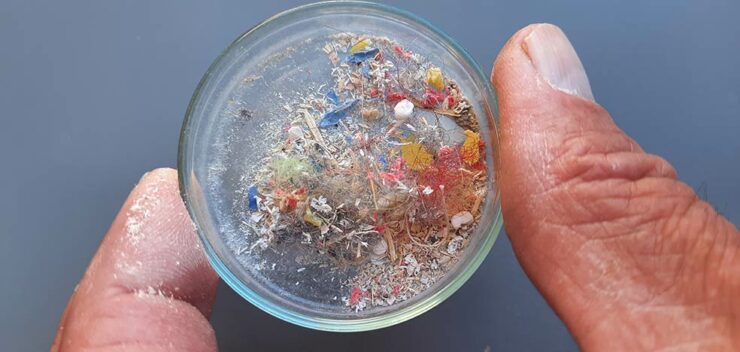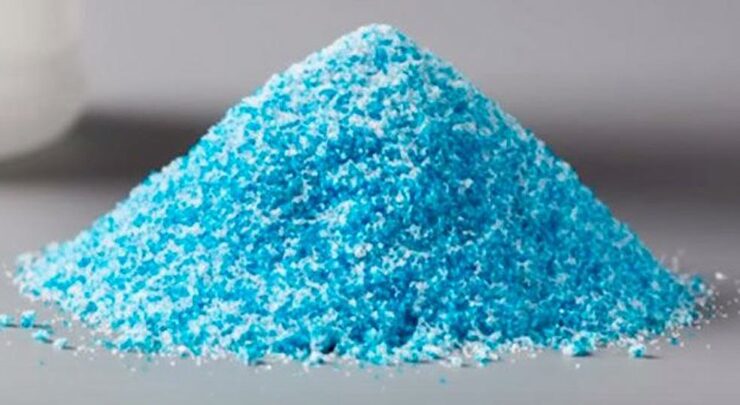News
Babies fed with plastic bottles swallow millions of microplastics every day
Juan J. García Vallejo has just demonstrated the presence of microplastics in our body. Together with the Dutch ecotoxicologist Dick Vethaak, one of the world’s leading experts on the subject, he tells us about it in this disturbing interview.
Check. Microplastics have reached our blood. This has just been confirmed by a research team led by the Spanish immunologist Juan J. García Vallejo. The finding represents a breakthrough in research aimed at understanding the effects that these microscopic particles have on our health. It implies that they are already circulating in our body and can therefore reach our organs.
Funded by the Dutch Organization for Health Research and Development (ZonMw), García Vallejo’s study (Inmunoplast) has been one of the major driving forces behind the creation of MOMENTUM, the largest European scientific consortium dedicated exclusively to investigating the consequences of increasing exposure to microplastics and nanoplastics for the human body. We talked about all this with Juan J. García Vallejo, who is joined by the Dutch ecotoxicologist Dick Vethaak, coordinator of the consortium and one of the world’s leading experts on microplastics. The researchers warn that there is no shortage of reasons for concern.

Microplastics have just been detected for the first time in human blood. What are the implications of this?
Juan J. García Vallejo Well, it was something foreseeable, given that plastic particles have invaded the environment, but it remained to be demonstrated that they are also invading our bodies. And it is scientifically plausible that they can be transported to the organs through the bloodstream.
And that they can accumulate there?
García Vallejo We don’t know yet, but it has already been proven that microplastics are capable of getting there. Shortly after publishing our finding, in fact, researchers in the United Kingdom have detected plastic particles in the lungs of living people. We do not know whether they got there through the respiratory tract or through the blood, but it is certainly another sign that further research is urgently needed.
Eighty percent of the people in your study had microplastics in their blood, can you give me more details?
García Vallejo The study was conducted with 22 healthy volunteers and we found plastic particles in 17 of them. Half of the blood samples showed traces of PET and more than a third had polystyrene. This is the first time we have been able to detect and quantify these chemical components in human blood. In other words, there are plastics in our bodies.
“By wearing surgical masks, so widespread as protection against COVID, we also breathe in microplastics.”
There are thousands of types of plastics, which ones have you found?
Garcia Vallejo We have identified and quantified five polymers of high production volume. The most common, but there are more than 5,000 plastic polymers.
What risk to our health does all this translate into?
García Vallejo We have already seen that these particles cause damage to human cells in the laboratory, but, at present, we are unaware of the effect this can have on our bodies. We need to better understand our exposure to these substances and validate the possible risks of all this.
Momentum has arrived. A world leading expert on microplastics, Dutch ecotoxicologist Dick Vethaak is one of the coordinators of Momentun, the largest European scientific consortium dedicated exclusively to investigating the consequences of increasing exposure to microplastics and nanoplastics for the human body. What further questions would then need to be answered?
Dick Vethaak There are so many. As you might say, the research in this field is just starting now. That’s why we have created the Momentum consortium. We want to look for answers to questions such as: where do these particles go, to which other organs, can they be eliminated, are they able to cross the blood-brain barrier that restricts the passage of toxic substances into the brain fluid, are these particles present in the plasma or are they carried by specific cell types, can these cells be involved in the translocation of particles through the mucosa into the bloodstream, can plastic particles affect immune regulation or predisposition to immune-based diseases? Furthermore, the study has focused on just five types of polymers, but there are many more. We need to develop new analysis techniques.
How does plastic get into our blood?
García Vallejo That is another question we are asking ourselves. The skin and mucous membranes, digestive and respiratory, form a very effective protection system, but we are talking about particles that can be in the nanoscopic range -from a hundred thousand to a million times smaller than a millimeter- which facilitates their penetration into our organs. They could, for example, adhere to cells, but more research is needed.
Have you seen parallels between the behavior of plastic and other known pollutants?
Vethaak Yes. In fact, when you consider the impact of plastic particles on the immune system, the big reference is all those pollutant particles that we already know about and that cause millions of premature deaths every year. A big risk in this regard would be the cascade of toxicity they cause, but we have no evidence yet that the plastic particles we have found trigger these kinds of mechanisms.
Do you mean that the way in which plastic particles act and their effects could follow similar patterns to other pollutant particles that we already know harm us?
García Vallejo That’s right. There is a mechanism for activating inflammatory cells in the innate immune system called the inflammasome, which is triggered by the presence of certain particles. They can be produced by the organism itself, such as uric acid crystals, but also by external contaminating particles. This is a typical process in which microplastics could have an impact, but we do not yet have evidence that the particles we have found trigger this mechanism or that it is the only mechanism. We need more research to see if the presence of microplastics does indeed have negative effects on the immune system.
“Plastic particles have invaded the environment, but it remained to be shown that they are also invading our bodies.”
I think there was a study on this with textile workers, wasn’t there?
Vethaak That’s right, but these were cases of exposure to extremely high concentrations of plastic particles, fibers, etc., on a daily basis for decades, which is not the norm. It caused them all kinds of diseases, including cancer. The general population is exposed to much lower concentrations, but this chemical exposure is increasing, and with it the potential risks to human health. If plastic can harm us, we must do something about it.
A 2019 Australian study revealed that we ingest on the order of one credit card per week. Does this figure fit you?
Vethaak Yes, it does. In fact, the most recent estimates reveal that we are exposed to 100 million microplastics every day. We breathe them, we eat them, we drink them, they stick to our skin; they are also found in toothpaste, lip gloss, tattoo ink…. Because of their chemical composition, there are many potential risks associated with these microplastics.

Another recent study reveals that nine out of ten products from major cosmetics brands contain microplastics…
Vethaak Actually, the scenario is much worse because it does not include the broad definition of microplastics that includes many more synthetic polymers. And the same with nanoplastics. All of those need to be reduced now, because they are potential producers of plastic particles. And nobody is talking about nanobeads, which we use for our hair, in the bathroom and go straight into the environment on a massive scale.
Anything else?
Vethaak Yes, yes, lest I forget: surgical masks, now so widespread by COVID. When you breathe with them on, plastic particles are released. They protect us from breathing in pollutants and viruses from the environment, but how many microplastics are we breathing in? And there are more. Plastic cups, bottles and other plastic containers are sources of direct exposure to nanoplastics. And have you heard of tea bags? Well, they release about 11.6 billion microplastics and 3.1 billion nanoplastic particles in the cup that end up in the digestive system.
How many years will it take to prove whether microplastics cause serious effects on our health?
Vethaak Ten to 15 years. It is a very complex issue, because we are talking about a very wide range of contaminants, some of which are very high risk. Microplastics and nanoplastics are general terms for a class of pollutants of great diversity in types, forms and compounds. Plus all the different types of molecules that are used as additives and cause problems to the human body. Exposure is what makes the difference. Without exposure there is no risk, but there are more and more of them.
In the meantime, what should the industry move forward on, what is most urgent?
García Vallejo The most urgent thing is to reduce the chemical additives that are added to plastic. This affects young children and babies, who are generally more vulnerable to exposure to chemicals and particles and the consequent risk of contracting diseases. In fact, some studies have detected levels of microplastics ten times higher in infant feces than in adult feces. Babies fed with plastic bottles, for example, swallow millions of plastic particles every day. That’s very worrisome.
“Microplastics that are degraded by UV rays and atmospheric factors accumulate microorganisms that, in our bodies, could represent a biological risk.”
Can it be said that the food chain is contaminated by microplastics?
Vethaak We lack solid, systematic research on microplastics in agriculture, but it is clear that livestock and fish feed can be contaminated with microplastics. Every time you mow your lawn, you shred plastic debris that ends up in livestock feed. How microplastics affect farm animal environments needs to be determined. Do they also end up in cows and their milk? There are indications that this is the case, but research needs to be done.
Can microplastics also be a pathway for pathogens to enter our bodies?
García Vallejo Yes, of course, some can absorb chemicals or pathogens and release them into our body. Keep in mind that microplastics degrade by the action of UV rays and atmospheric elements and accumulate microorganisms that could represent a biological risk. In the Momentun consortium we also investigate all this, but there is a big knowledge hole in this topic. For example, we are now beginning to understand that, as soon as particles reach the environment, an eco-corona appears around them, which probably plays an important role in the generation of toxicity. That is a very interesting line of research. I hope that, shortly, we will be able to tell you some more things.
This article was originally published in Spanish in El Correo on April 24 by Fernando Goitia.




